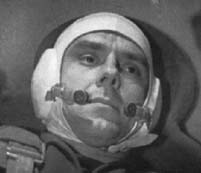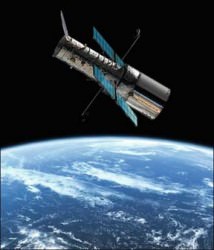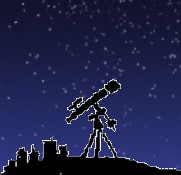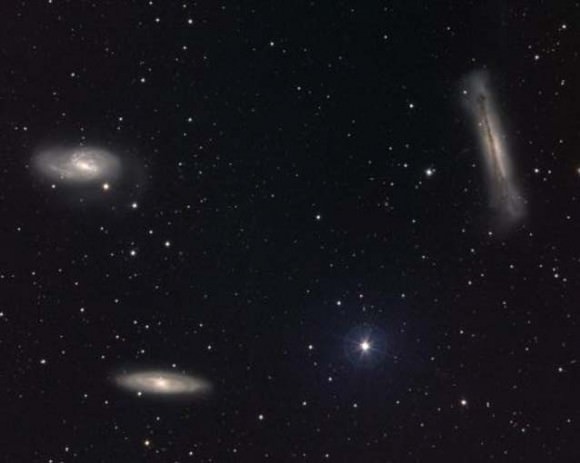Greetings, fellow SkyWatchers! Are you ready for one grrrrrrreat weekend? Then let’s do a little lion taming while the Moon is out of the picture and hunt down the “Leo Trio”. For you pirates in the crowd, hoist the Jolly Roger, because it’s time we took a look at the “Skull and Crossbones”, too! Prefer to relax? No problem. The Mu Virginid meteor shower will be in town on Saturday night for your kicked back pleasure and Sunday is time for a Herschel challenge. Time to dust off the binoculars and telescopes and I’ll see you in the back yard…
 Friday, April 24, 2009 – On this date in 1970, China launched its first satellite. Named Shi Jian 1, it was a successful technological and research craft. This achievement made China the fifth country to have sent a vessel into space. Observe a moment of silence for Vladimir Mikhailovich Komarov, the first man known to have died during a space mission. He was Command Pilot of Voskhod 1 and Soyuz 1. Komarov died during the landing of the Soyuz, when the spacecraft became entangled in its main parachute and fell several miles to Earth.
Friday, April 24, 2009 – On this date in 1970, China launched its first satellite. Named Shi Jian 1, it was a successful technological and research craft. This achievement made China the fifth country to have sent a vessel into space. Observe a moment of silence for Vladimir Mikhailovich Komarov, the first man known to have died during a space mission. He was Command Pilot of Voskhod 1 and Soyuz 1. Komarov died during the landing of the Soyuz, when the spacecraft became entangled in its main parachute and fell several miles to Earth.
Tonight let’s do a galaxy hop that’s relatively easy for larger binoculars and small telescopes. You’ll find a pair of galaxies almost perfectly mid-way between Theta and Iota, and their names are M65 (RA 11 18 55 Dec +13 05 32) and M66 (RA 11 20 15 Dec +12 59 21). Discovered by Mechain in March 1780, apparently Messier didn’t notice the bright pair when a comet passed between them in 1773. At around 35 million light-years away, you will find M66 to be slightly brighter than its 200,000 light-year-distant western neighbor, M65. Although both are Sb-class spirals, the two couldn’t appear more different. M65 has a bright nucleus and a smooth spiral structure, with a dark dust lane at its eastern edge. M66 has a more stellar-like core region with thick, bright arms that show knots to larger scopes, as well as a wonderful extension from the southern edge.
If you are viewing with a larger scope, you may notice to the north of this famous pair yet another galaxy. NGC 3628 (RA 11 20 16 Dec +13 35 13) is a similar magnitude edge-on beauty with a great dissecting dark dust lane. This pencil-slim, low surface brightness galaxy is a bit of a challenge for smaller scopes, but larger ones will find its warped central disk well worth high-power study. You may also be able to spot the ‘‘Leo Trio’’ and members of Arp’s Peculiar Galaxy Catalog!
 Saturday, April 25, 2009 – Today marks the 19th anniversary of the deployment of the Hubble Space Telescope (HST) . Although everyone in the astronomical community is well aware of what this magnificent telescope ‘‘sees,’’ did you know you could see it with just your eyes? The HST is a satellite that can be tracked and observed. Visit www.heavens-above.com and enter your location. This page will provide you with a list of visible passes for your area. Although you can’t see details of the scope itself, it’s great fun to track it with binoculars or see the Sun glinting off its surface in your scope.
Saturday, April 25, 2009 – Today marks the 19th anniversary of the deployment of the Hubble Space Telescope (HST) . Although everyone in the astronomical community is well aware of what this magnificent telescope ‘‘sees,’’ did you know you could see it with just your eyes? The HST is a satellite that can be tracked and observed. Visit www.heavens-above.com and enter your location. This page will provide you with a list of visible passes for your area. Although you can’t see details of the scope itself, it’s great fun to track it with binoculars or see the Sun glinting off its surface in your scope.
Tonight is the New Moon. You’ve got dark skies ahead and hopefully an itch to see something out of the ordinary with your telescope. If so, let’s go south and locate a fine reflecting nebula – NGC 2467 – in northern Puppis (RA 07 52 19 Dec –26 26 30). Sometimes referred to as the ‘‘Skull and Crossbones Nebula,’’ this billowing cloud of gas and dust is easily found less than a finger-width south-southeast of 3.5 magnitude Xi Puppis.
Even small telescopes will find this expansive, starstudded emission nebula, a real beauty! Large aperture telescopes should look for neighboring splotches of nebulosity illuminated by small groupings of stars, some of which are part of a newly forming open cluster. Keep in mind while observing NGC 2467 that we are seeing it from a great distance. At 17,000 light-years away, this region of star formation is some 10 times farther away than the Great Nebula in Orion. If it were the same distance away, NGC 2467 would dwarf M42!
While you’re out, keep an eye turned toward the sky as the Mu Virginid meteor shower reaches its peak at 7–10 per hour. With dark skies early tonight, you might catch one of these medium-speed meteors radiating from a point near the constellation of Libra.
 Sunday, April 26, 2009 – On this date in 1920, the Shapely–Curtis debate raged in Washington on the nature of (and distance to) spiral nebulae. Shapely claimed they were part of one huge galaxy to which we all belonged, while Curtis maintained they were distant galaxies of their own. Thirteen years later on the same date, Arno Penzias was born. He went on to become a Nobel Prize winner for his part in the discovery of the cosmic microwave background radiation while he was searching for the source of the ‘‘noise’’ coming from a simple horn antenna. His discovery helped further our understanding of cosmology in ways Shapely and Curtis could never have dreamed of.
Sunday, April 26, 2009 – On this date in 1920, the Shapely–Curtis debate raged in Washington on the nature of (and distance to) spiral nebulae. Shapely claimed they were part of one huge galaxy to which we all belonged, while Curtis maintained they were distant galaxies of their own. Thirteen years later on the same date, Arno Penzias was born. He went on to become a Nobel Prize winner for his part in the discovery of the cosmic microwave background radiation while he was searching for the source of the ‘‘noise’’ coming from a simple horn antenna. His discovery helped further our understanding of cosmology in ways Shapely and Curtis could never have dreamed of.
Tonight we’re off to study another Herschel object (H II.506) in Hydra that’s a 7 degree drop south of Alpha – NGC 2907 (RA 09 31 42.1 Dec –16 44 04). Although it will require at least a mid-aperture telescope to reveal, this edge-on galaxy is quite worth the trouble. NGC2907 is highly prized because of research done on its dust extinction properties, which greatly resemble those of our own Milky Way Galaxy. For larger telescopes, averted vision will call up a hint of a dark dust lane across a bright core. Although it is neither particularly huge nor particularly bright, this object will present an interesting challenge for those with larger scopes looking for something a bit out of the ordinary.
Until next week, remember… Dreams really do come true when you keep on reaching for the stars!
This week’s awesome images are (in order of appearance): Vladimir Mikhailovich Komarov (historical image), M65, M66 and NGC 3628: the Leo Trio (credit—REU Program/NOAO/AURA/NSF), Hubble SpaceTelescope (credit—NASA), NGC 2467 (credit—Palomar Observatory, courtesy of Caltech), Arno Penzias (widely used public image) and NGC 2907 (credit—Palomar Observatory, courtesy of Caltech). We thank you so much!





HST is making passes over Florida,roughly around 9pm est this weekend
a spectacular showing of the mu virginids here… far better than i anticipated! lots of activity between 10 pm and 1 am. hopefully others got to enjoy the show as well!